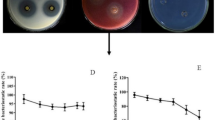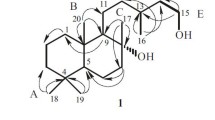Abstract
The effectiveness of a bacteriocin-like substance (BLS) produced by Bacillus amyloliquefaciens was tested against Acanthamoeba polyphaga strains, and its cytotoxic potential on Vero cells was investigated. Amebicidal activity of the purified BLS was tested by plate bioassays with concentrations ranging from 12.5 to 6,400 AU mL−1. Damage to A. pholyphaga cells was monitored using an inverted microscope and counted in a Fuchs–Rosenthal chamber after 24, 48, and 72 h. According to the results obtained, the BLS showed remarkable amebicidal and amebostatic effect on A. polyphaga and showed no cytotoxicity on the Vero cells. These results may have great relevance in the development of new acanthamoebicidal compounds.


Similar content being viewed by others
References
Arrighi RB, Nakamura C, Miyake J, Hurd H, Burgess JG (2002) Design and activity of antimicrobial peptides against sporogonic-stage parasites causing murine malarias. Antimicrob Agents Chemother 46(7):2104-2110
Awwad ST, Petroll WM, McCulley JP, Cavanagh HD (2007) Updates in Acanthamoeba keratitis. Eye Contact Lens 33:1–8
Carvalho FR, Foronda AS, Mannis MJ, Höfling-Lima AL, Belfort R Jr, de Freitas D (2009) Twenty years of Acanthamoeba Keratitis. Cornea 28:516–519
Clarke DW, Niederkorn JY (2006) The pathophysiology of Acanthamoeba keratitis. Trends Parasitol 22:175–180
De Jonckheere JF (1980) Growth characteristics, cytopathic effect in cell culture, and virulence in mice of 36 type strains belonging to 19 different Acanthamoeba spp. Appl Environ Microbiol 39:681–685
Fiori PL, Mattana A, Dessı D, Conti S, Magliani W, Polonelli L (2006) In vitro acanthamoebicidal activity of a killer monoclonal antibody and a synthetic peptide. J Antimicrob Chemother 57:891–898
Gopinathan U, Sharma S, Garg P, Rao GN (2009) Review of epidemiological features, microbiological diagnosis and treatment outcome of microbial keratitis: experience of over a decade. Indian J Ophthalmol 57:273–279
Goze I, Alim A, Dag S, Tepe B, Polat ZA (2009) In vitro amoebicidal activity of Salvia staminea and Salvia caespitosa on Acanthamoeba castellanii and their cytotoxic potentials on corneal cells. J Ocul Pharmacol Ther 25:293–298
Illingworth CD, Cook SD (1998) Acanthamoeba keratitis. Surv Ophthalmol 42:493–508
Kumar R, Lloyd D (2002) Recent advances in the treatment of Acanthamoeba keratitis. Clin Infect Dis 35:434–441
Lisboa MP, Bonatto D, Bizani D, Henriques JAP, Brandelli A (2006) Characterization of a bacteriocin-like substance produced by Bacillus amyloliquefaciens isolated from the Brazilian Atlantic Forest. Int Microbiol 9:111–118
Lloyd D, Turner NA, Khunkitti W (2001) Encystation in Acanthamoeba castellanii: development of biocide resistance. J Eukaryot Microbiol 48:11–16
Lowry OH, Rosebrough NJ, Farr AL, Randall RJ (1951) Protein measurement with the Folin phenol reagent. J Biol Chem 193:267–275
Ma P, Visvesvara GS, Martinez AJ, Theodore FH, Daggett PM, Sawyer TK (1990) Naegleria and Acanthamoeba infections: review. Rev Infect Dis 12:490–513
Marciano-Cabral F, Cabral GA (2003) Acanthamoeba spp. as agents of disease in humans. Clin Microbiol Rev 16:273–307
Martinez MS, Gonzalez-Mediero G, Santiago P, Rodriguez de Lope A, Diz D, Visvesvara GS (2000) Granulomatous amebic encephalitis in a patient with AIDS: isolation of Acanthamoeba sp. group II from brain tissue and successful treatment with sulfadiazine and fluconazole. J Clin Microbiol 38:3892–3895
Mills R (2003) Microbial keratitis, what’s the preferred initial therapy? View 1: corneal scraping and combination antibiotic therapy is indicated. Br J Ophthalmol 87:1167–1169
Motta AS, Brandelli A (2002) Characterization of an antibacterial peptide produced by Brevibacterium linens. J Appl Microbiol 92:63–71
Papagianni M (2003) Ribosomally synthesized peptides whit antimicrobial properties: biosynthesis, structure, function, and applications. Biotechnol Adv 21:465–499
Polat ZA, Vural A, Tepe B, Cetin A (2007) In vitro amoebicidal activity of four Allium species on Acanthamoeba castellanii and their cytotoxic potentials on corneal cells. Parasitol Res 101:397–402
Reddy KVR, Yedery RD, Aranha C (2004) Review: antimicrobial peptides: premises and promises. Int J Antimicrob Agents 24:536–547
Ródio C, Vianna DR, Kowalski KP, Panatieri LF, von Poser G, Rott MB (2008) In vitro evaluation of the amebicidal activity of Pterocaulon polystachyum (Asteraceae) against trophozoites of Acanthamoeba castellanii. Parasitol Res 104:191–194
Sacramento RS, Martins RM, Miranda A, Dobroff ASS, Daffre S, Foronda AS, De Freitas D, Schenkman S (2009) Differential effects of α-helical and β-hairpin antimicrobial peptides against Acanthamoeba castellanii. Parasitology 136:813–821
Saragoza R (1994) Ecology of free-living amoebae. Crit Rev Microbiol 20:225–241
Schuster FL, Visvesvara GS (1998) Efficacy of novel antimicrobials against clinical isolates of opportunistic amebas. J Eukaryot Microbiol 45:612–618
Schuster FL, Visvesvara GS (2004) Free-living amoebae as opportunistic and non-opportunistic pathogens of humans and animals. Int J Parasitol 34:1001–1027
Author information
Authors and Affiliations
Corresponding author
Rights and permissions
About this article
Cite this article
Benitez, L.B., Caumo, K., Brandelli, A. et al. Bacteriocin-like substance from Bacillus amyloliquefaciens shows remarkable inhibition of Acanthamoeba polyphaga . Parasitol Res 108, 687–691 (2011). https://doi.org/10.1007/s00436-010-2114-5
Received:
Accepted:
Published:
Issue Date:
DOI: https://doi.org/10.1007/s00436-010-2114-5




